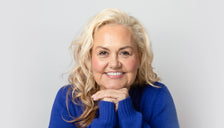Dr Rajpar is a Consultant Dermatologist and has an interest in skin and hair concerns around the menopause. www.midlandskin.co.uk
As a dermatologist, I have been seeing and treating patients with skin problems for over 17 years. I was never taught, nor did I ever fully understand, the importance of oestrogen to the skin until later in my career.
It turns out oestrogen is an extremely important hormone for healthy looking and healthy functioning skin. Skin and hair issues are incredibly common around the perimenopause and menopause. Many of the skin problems seen can be significantly improved with Hormone Replacement Therapy (HRT).
Oestrogen levels first start dropping during the peri-menopause, which can last for up to 10 years before the onset of the menopause. At first, the changes are quite subtle and are often attributed to stress, ageing, pollution or a change in weather. Here are the most common problems I encounter in my clinical practice.
Dry skin and dullness
Skin dryness is one of the earliest problems suffered by women in the perimenopause and menopause suffer from. At first, this might only affect arms and legs in the winter months. The skin becomes more prone to itching and looks visibly drier. Eczema and psoriasis sometimes worsen.

Facial skin also becomes dry and doesn’t hydrate with moisturisers as well as it used to. For some women, dry skin can be a debilitating symptom, and can even be associated with formication, which is the sensation of insects crawling on the skin. This can interfere with sleep and cause a lot of discomfort.
The reason why skin becomes dry when oestrogen levels drop is because the skin’s in-built moisturising system needs oestrogen to work properly. This special system holds water in the skin and stops it from evaporating. Ceramides coat the epidermal skin cells, a bit like mortar around bricks. When ceramide levels drop due to a lack of oestrogen, this special seal around the skin, known as the ‘skin barrier’, doesn’t work as well and water evaporates. It also means that skin is more sensitive and there can be facial burning and stinging caused by soaps, foaming cleansers, acids and even fragrances. Oestrogen also pushes sebum and hyaluronic acid levels up, and without these, the skin cannot hold moisture in.
Lack of skin hydration means the skin cells don’t exfoliate properly – enzymes that allow exfoliation to happen just don’t work as well in dry skin. Instead, skin cells form clumps before shedding. These clumps make the skin feel rough and look dull. The clumps can cause skin to flake and scales can be seen. Many people say the skin looks as if it has lost its glow.
Fine lines and wrinkles
It is common knowledge that bones become thin and brittle after the menopause, but the skin also becomes thinner. One study showed that the skin thins at a rate of 1.1% year-on-year after the menopause. The main reason for this is that oestrogen is required for collagen production in the skin. Collagen is the main protein in the skin that gives it structure and resilience. The collagen levels go down 2.1% per year after the menopause. With less collagen, fine lines and wrinkles start to appear. Later these become deeper lines and folds.
Collagen levels in the skin improve with HRT. A good skin care regime that includes a sun screen, antioxidants and peptides can also help reduce ageing of the skin.
Sagging and jowling
The bones of the face also shrink with age, and research has shown that the jaw bone and chin shrink faster than other areas of the face with the onset of the menopause. Consequently, women become prone to sagging and jowling, with heaviness on the lower face.
Delayed wound healing
Menopausal skin is more fragile and wounds do not heal as well or as quickly in post-menopausal women who are not on HRT.
Acne and rosacea
Testosterone is not just a male hormone, as women produce testosterone too. In the early stages of perimenopause and menopause, there may be an imbalance between oestrogen and testosterone. As the oestrogen levels drop, the testosterone levels may remain normal, and stimulate the hair follicles more than they used to. This can lead to very frustrating acne break outs and redness.
Rosacea can develop around the menopause as spots on the central face, or as redness on the cheeks with thread veins. Flushing can be a symptom of the menopause but can also be a symptom of rosacea. Skin that has rosacea tendencies is also usually very sensitive and reacts to strong skin care.
Hair loss
Hair loss can be a devastating symptom of the menopause and affect self-esteem and self-confidence. One study showed that 41% of post-menopausal women experience hair loss. About two thirds lose hair all over their scalp, while one third loses hair in the front and temples. The mechanism for hair loss with the menopause is not fully understood. For some, it may be a sensitivity to testosterone in the same way that acne develops. For others it may that they have genetic hair loss known as female pattern hair loss, which worsens with menopause.
Conclusion

Skin and hair changes are common with the menopause and can cause significant symptoms and distress. Many symptoms can be improved or completely treated with HRT, especially when this is started early. Others may require a good skin care regime and professional medical treatment.





























